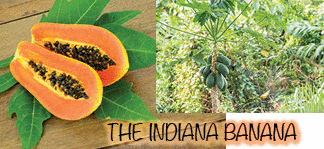Return to 1st Quarter 2018 articles.


When I was a kid living in southern Indiana, we had a fruit called paw paws also known as “Indiana bananas” (Asimina triloba). They were ripe in October when the green color lightened and looked a little yellow like a banana. If it was soft to a squeeze and had some black spots on it, you could eat it. It was custard-like and had a unique tropical flavor, but it soured quickly and could be nasty if it was too green or too ripe. What I did not understand was that the paw paw is a medicinal agent with a variety of beneficial uses.
Paw paws contain a group of chemicals called acetogenins. These chemicals interfere with the electron transfer in the mitochondria of cells reducing the cell's energy transport system which cancer cells use. A chemical in the paw paw called bullatacin is 300 times as potent as Taxol, and its use as a cancer-fighting drug is ongoing. The paw paw tree also has an excellent pesticide, so it is a very versatile plant.
When God created the animals and plants, he made them to serve each other in many ways. It takes an incredible design to take care of food requirements, pest control, and medical issues. God even designed some plants to solve pollution issues. The brake fern (Pteris vittata) for example, absorbs, and thrives on arsenic and can remove it from contaminated soil 4,000 times better than conventional plants. Animals learn to use the properties of plants. Chimps and gorillas eat plants that science has discovered can kill parasites, bacteria, and fungi.
Indiana bananas have a positive reputation among Hoosiers who know how good they can be. Also, foxes, opossums, squirrels, and raccoons will eat them, but deer, goats, and rabbits will not eat the leaves, twigs or bark. When God created the biosphere of Earth, he had some incredible challenges, and as we study plants like the paw paw we see just how wise and complete God's planning has been. Sources: New Scientist, February 1992, page 18; Scientific American, December 1996, page 20; and www.crfg.org/pubs/ff/pawpaw.html.
Picture credits:
Top left: © Areeya_ann; top right: © Patjo. Both images from BigStockPhoto.com.
